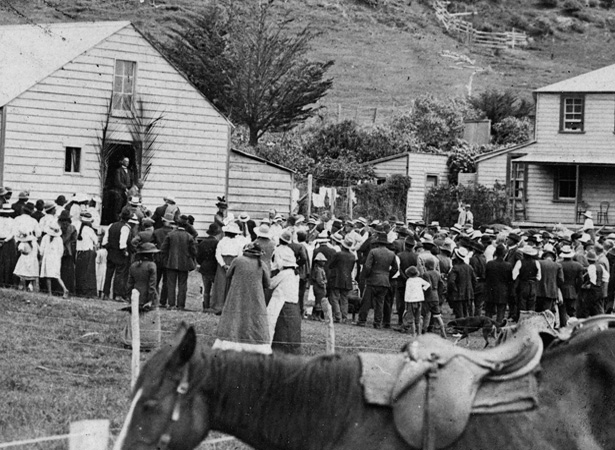
The Native Land Court was one of the key products of the Native Lands Act 1865. It enabled the conversion of traditional communal landholdings into individual titles, making it much easier for Pākehā to purchase Māori land.
Coming little more than a year after the Waikato War, this legislation was to achieve what many believed had not been accomplished on the battlefield – acquiring the land necessary to satisfy settlers’ appetites. The operations of the Land Court affected Māori more strongly than those of any other colonial institution. When old rivalries were played out in court, the ultimate beneficiaries were Pākehā. Historian Judith Binney described the Native Lands Act as an ‘act of war’.
The Court was required to name no more than 10 owners, regardless of the size of a block. All other tribal members were effectively dispossessed. The newly designated owners held their lands individually, not communally as part of (or trustees for) a tribal group. They could manage it, and sell it, as individuals and for their own benefit.
The first chief judge of the Court, Francis Fenton, maintained that judgements could only be based on the evidence presented to the Court. To protect their interests, all claimants had to attend in person, whether they wanted to or not. Many racked up large legal bills as a result. Those from out of town also had to pay for food and accommodation. Lawyers, shopkeepers, surveyors and the like granted Māori credit while they awaited the outcome of their case. These expenses forced many to sell the land they had been defending to settle their debts.
This process of alienating Māori land concerned some settler politicians. Former Attorney-General Henry Sewell had protested against the government’s policy of confiscating the land of Māori deemed to be ‘in rebellion’. Back in office in 1865, he asserted that the Native Land Court was designed to:
destroy if possible, the principle of communism which ran through the whole of their institutions, upon which their social system was based, and which stood as a barrier in the way of all attempts to amalgamate the Native race into our own social and political system.
Māori landholdings declined dramatically in the late 19th century. Between 1870 and 1892, 2 million ha of Māori land was transferred to Pākehā ownership. Whereas at the signing of the Treaty of Waitangi in 1840 Māori owned almost all of the North Island, by 1892 they owned little more than a third, and a quarter of this was leased to Pākehā. Another 1.2 million ha of Māori land would be sold by 1900.
Read more on NZHistory
Obtaining land – The Treaty in practiceFrederick WeldHistory of New Zealand, 1769-1914 – A history of New Zealand 1769-1914
External links
How to cite this page
'Native Land Court created ', URL: https://nzhistory.govt.nz/page/native-land-court-created, (Ministry for Culture and Heritage), updated 16-Mar-2021
